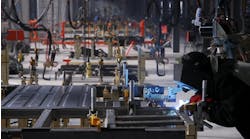How & why to commit your company to net-zero steel
By Rob Jenkinson, Global EHS Leader at SKF, and Jen Carson, Senior Project Manager, Climate Group
The challenges for companies that rely on steel have been numerous, especially throughout the COVID-19 pandemic. However, there are still more challenges on the horizon, especially as we strive to hit Intergovernmental Panel on Climate Change (IPCC) targets for emissions in 2030 and 2050.
With steel being the world’s most widely used material and one of the most energy-intensive to produce and ship, the steel sector is currently responsible for 7% of global carbon emissions each year. As demand increases, this number will continue to rise unless companies take individual action and join together to address decarbonization across the entire value chain.
In general, people see climate action as a moral imperative, but, for our industry, there is a strong commercial imperative to act as well. A recent CDP report determined that 14% of steel companies’ potential value is at risk if we do not reduce our environmental impact, and investors agree that the time to act is now to safeguard the steel industry’s future. Users of steel, too, are asking about the amount of embodied carbon in suppliers’ products as a deciding factor on whom they will do business with.
Currently about 80-90% of steel is recycled globally to produce secondary steel—a process three times less carbon-intensive than producing primary steel from iron ore. But only 30% of global steel consumption annually can be met by using secondary steel. That leaves 70% of steel needing to be created through a highly energy-intensive process currently dominated by fossil-fuel use.
At SKF, steel is our primary raw material. In 2020, we purchased 446,000 tons of steel, and our CO2 emissions total about 1.8 million tons per year. We did the research across our organization and supply chain and found that our largest percentage of emissions comes from sourcing direct material, followed by emissions from our factories, and then logistics. Embodied carbon in the steel materials and components SKF buys represents between 60-90% of the total emissions generated across our value chain from raw material to finished product.
For us, it made sense to prioritize decarbonizing the upstream value chain for steel.
We were confident we could get our own factories to net zero by 2030 by improving energy and material efficiency and by switching to 100% renewable energy for our operations. However, we also knew that our operations only accounted for a relatively small part of our overall carbon footprint. We needed to examine what was beyond our direct control—everything from raw-material extraction to the finished product delivered to the customer—to get to net zero.
In order to gain more knowledge and have more influence across the value chain, SKF joined forces with other forward-looking companies through SteelZero, an initiative run by Climate Group in partnership with ResponsibleSteel. SteelZero asks its member organizations to commit to use, procure or specify 100% net zero steel by 2050, and to use 50% low-carbon steel by 2030. It engages companies at every step of the supply chain to drive a viable demand signal for net-zero steel, and helps companies come together to pool their influence with policymakers to address barriers to achieving these goals.
Costs related to carbon and energy pricing are projected to keep rising over the next few years. Businesses need to understand what their CO2 footprint is—upstream—in order to stay ahead of those costs and other risks. Taking action now enables you to prepare for the inevitable changes across supply chains and to mitigate some of the challenges we’re already seeing.
As your company starts this decarbonization process, keep in mind this is not just a job for your procurement team or your corporate-sustainability department. It’s important to have a cross-functional and cross-departmental team to evaluate your operations and the full lifecycles of your products and processes, and build your business case across the organization.
Everyone across your value chain—from designers and R&D to sales and strategy—needs to understand what the data you collect reveals, what the changes to your company and carbon footprint are, why it’s important to achieve net-zero steel, and what role everyone plays in reaching your targets.
Breaking down your goals into interim targets for each category can give you more flexibility to adapt and even increase the ambition level of your goals as the supply base develops new technology and government policies evolve. Joining an initiative like SteelZero is another decision that should be made cross-functionally and cross-departmentally.
A commitment to a net zero-supply chain, and sustainability overall, requires an enterprise approach and alignment across functions for success. We know these targets are bold but we also feel they’re achievable, especially if the industry works on this together.



